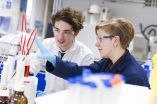Researchers are presenting the results of their work today at the 250th National Meeting & Exposition of the American Chemical Society (ACS), the world's largest scientific society. The meeting features more than 9,000 presentations on a wide range of science topics and is being held here through Thursday.
"Alcoholism is a major problem in the U.S.," V. V. N. Phani Babu Tiruveedhula says. "Alcohol abuse costs almost $220 billion to the U.S. economy every year. That's a shocking number. We need a better treatment right now." Tiruveedhula is a graduate student at the University of Wisconsin, Milwaukee.
The exact causes of alcoholism are not well understood, but the researchers explain that the urge to drink is related to the brain's pleasure centers. Scientists have found that alcohol triggers the brain to release dopamine, the same neurochemical whose levels increase in response to pleasurable behavior like eating, sex or listening to music.
Some drugs currently available to treat alcoholism are aimed at dopamine. "They dampen out the dopamine system a little bit, so you don't get so happy when you have an alcoholic beverage," says James Cook, Ph.D., a chemist at the University of Wisconsin, Milwaukee, who advises Tiruveedhula. But these medications, derived from a class of compounds called opioid antagonists, cause depression in some patients, Cook notes. And they're addictive themselves, which can lead to drug abuse. Valium is an example of another common drug used to treat alcoholism that is also addictive.
Looking for an alternative, Cook focused on molecules known to cause some of the same results as Valium and the opioid antagonists without the unwanted side effects. For almost two decades, Cook collaborated with the late Harry June, Ph.D., a psychopharmacologist at Howard University. They conducted laboratory tests to understand the effects of these new compounds and to discover which ones work best.
Now, Tiruveedhula has made several of these promising beta-carboline compounds that could represent the future of alcoholism treatment. Tiruveedhula simplified their manufacture from eight steps to just two, while increasing the yield tenfold and eliminating unwanted byproducts. Cook says these potential medications could be taken orally.
In tests using rats bred to crave alcohol, the scientists found that administering these compounds drastically diminished the rats' drinking. What's more, they observed very few of the side effects common to alcoholism treatment drugs, such as depression and losing the ability to experience pleasure. The drugs appeared to reduce anxiety in "alcoholic" rats, but not in control rats. Because this is different from what is seen with current drugs, the researchers think the result hints that the new compounds work much differently than opioid antagonists. As such, the beta-carbolines may also be less addictive.
"What excites me is the compounds are orally active, and they don't cause depression like some drugs do," says Cook.
The group is continuing to test the compounds in additional animal studies. Cook has patented several of the most promising compounds, and he is starting to explore possible partnerships with drug makers that could lead to medications.
If everything works out, Cook says, a drug could be ready for the market in five to six years.
INFORMATION:
A press conference on this topic will be held Wednesday, Aug. 19, at 10:30 a.m. Eastern time in the Boston Convention & Exhibition Center. Reporters may check-in at Room 153B in person, or watch live on YouTube http://bit.ly/ACSLiveBoston. To ask questions online, sign in with a Google account.
The researchers acknowledge funding from the National Institute on Alcohol Abuse and Alcoholism.
The American Chemical Society is a nonprofit organization chartered by the U.S. Congress. With more than 158,000 members, ACS is the world's largest scientific society and a global leader in providing access to chemistry-related research through its multiple databases, peer-reviewed journals and scientific conferences. Its main offices are in Washington, D.C., and Columbus, Ohio.
To automatically receive news releases from the American Chemical Society, contact newsroom@acs.org.
Note to journalists: Please report that this research was presented at a meeting of the American Chemical Society.
Follow us: Twitter | Facebook
Title
Design and regiospecific synthesis of 3-substituted β-carbolines as a GABAA subtype selective agents for the treatment of alcohol abuse
Abstract
Alcohol abuse is known to mediated, in part, by GABAA receptors. GABAA receptors are the major inhibitory chloride ion channels while γ-aminobutyric acid (GABA) is the endogenous ligand for this system in the central nervous system. Alcoholism plays a significant role in public health concerns impacting physical and mental well-being, family structure and occupational stability. β-Carboline-3-carboxylate-t-butyl ester [βCCt] and 3-propoxy-β-carboline hydrochloride [3PBC·HCl] function as mixed benzodiazepine receptor agonist-antagonists, and they preferentially bind at the benzodiazepine GABAA α-1 receptor. Results have shown that systemic and direct infusion of βCCt or 3-PBC·HCl into the ventral pallidum produces remarkably selective reduction in alcohol responding in alcohol preferring (P) and high alcohol drinking (HAD) rats. The ligands were also weakly anxiolytic in these genetic rat lines but not anxiolytic in normal rats. This indicates that these types of β-carbolines may represent a non-addicting treatment for human alcoholics. Initially βCCt and 3-PBC were synthesized via a 5 step (35 % yield) and 8 step (8 % yield) protocol, respectively. In an attempt to replace these time consuming syntheses, a new route involving 2 steps was developed. This new route involved a palladium catalyzed Buchwald-Hartwig coupling, and an intramolecular Heck reaction as key steps. The later reaction led to two regioisomeric β- and d- carbolines. Regioselective synthesis of β-carbolines was achieved by simply changing the chlorine position from the benzene ring to the pyridine ring. This 2-step protocol decreased the number of steps, eliminated the unwanted regioisomer and improved the overall yields. Using this protocol a number of 3-substituted β-carbolines analogs were synthesized. Among these analogs, 3-ISOPBC·HCl appeared to be a potential lead anti-alcohol (self-administration) agent active against binge drinking in maternally deprived (MD) rats. The development, application of this synthetic route and in vivo studies will be presented.

